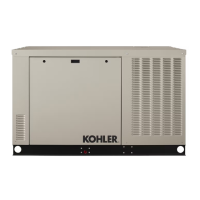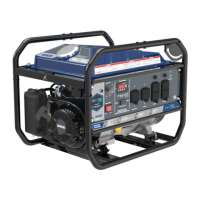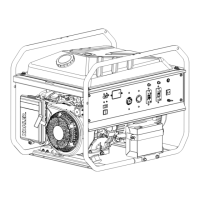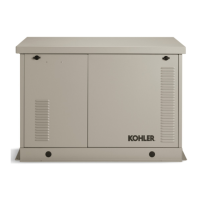TP-6907 5/1696 Section 7 Disassembly/Reassembly
7.6 Engine Disassembly
See Figure 7-6 for 24 RCL engine component
identification. See Figure 7-7 for 30RCL and 38RCLB
turbocharged engine components. The following
instructions cover the general steps for removing the
engine from the skid. See the engine service manual for
detailed disassembly/assembly instructions. See
Appendix C for torque specifications.
1. Be sure to perform the initial steps described in
Section 7.2 before p roceeding.
Note: If the generator set is equipped with a block
heater, make sure that the heater is
unplugged before draining the coolant.
2. Drain the coolant from the engine.
3. Disconnect the oil drain hose.
4. Disconnect the coolant hoses.
Note: The turbocharged engine on the 30RCL and
38RCLB has additional coolant hoses for
the charge air cooler and the oil cooler.
5. To remove the air cleaner:
a. Disconnect the crankcase vent hose.
b. Disconnect the air intake elbow from the throttle
body.
c. Remove the screws that secure the air intake
bracket to the engine.
6. Disconnect the fuel vacuum hoses from the throttle
body and the fuel control valve. Disconnect the fuel
intake hose from the throttle body.
7. Label and disconnect the engine wire harness from
the following:
D Ground leads and battery ground on the
engine.
D ECM
D Heated Exhaust Gas Oxygen (HEGO) sensor
8. Remove the nuts on the exhaust flange and
disconnect the exhaust. Remove the old exhaust
gasket and obtain a gasket for the reassembly
procedure.
9. To remove the engine:
a. Install the lift hooks onto the engine.
Note: The lift hooks are available for purchase as
serviceable parts. Refer to the engine parts
catalog.
b. Connect a hoist to the lift hooks.
Note: Use a hoist or lifting device that is rated for
the weight of the generator set. See
Section 7.2.
c. Remove the bolts connecting the engine to the
engine feet.
d. Use the hoist to lift and remove the engine.






